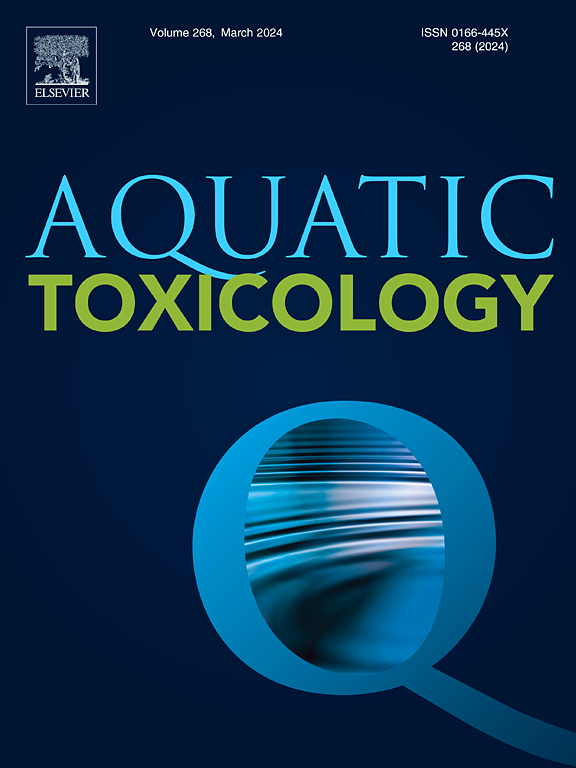评估合成防腐剂 Quaternium - 15 对三种模式生物的影响:关于环境风险的新见解。
IF 4.1
2区 环境科学与生态学
Q1 MARINE & FRESHWATER BIOLOGY
引用次数: 0
摘要
COVID-19 大流行之后,季铵盐化合物由于具有抗菌剂、稳定剂和消毒剂的功效,其使用量成倍增加。其中,季铵盐-15 是一种防腐剂,用于配制各种个人护理产品。这种物质使用量的增加以及由此导致的在废水处理系统中的持久性(该系统无法完全去除水中的季铵盐-15)日益引起环境关注。本研究利用胚胎毒性分析,旨在调查接触 Quaternium-15 对非目标物种的影响以及由此对环境造成的风险。通过死亡率、孵化率、是否畸形、心跳变化和动物体长等胚胎毒性终点,评估了三种模式生物(鲤鱼、丹顶鹤、爪蟾)在接触六种不同浓度的 Quaternium-15(1、5、10、15、20 和 25 mg/L)96 小时后受到的影响。分析结果表明:在测试的最高浓度下,所有三种模式生物的胚胎在 96 hpf 后全部死亡;与对照组相比,鲤鱼和鲫鱼的孵化期推迟;所选的所有模式生物均出现畸形;鱼类模式的心跳率显著下降。这些观察结果都表明季铵盐-15 与水生生物之间存在负面相互作用,因此有必要进行进一步调查,以防止对生态系统和非目标物种造成损害。本文章由计算机程序翻译,如有差异,请以英文原文为准。
Appraisal of a synthetic preservative, Quaternium – 15, effect on three model organisms: new insight on environmental risks
After the COVID-19 pandemic, the use of quaternary ammonium compounds increased exponentially due to their efficacy as antimicrobials, stabilizers and disinfectants. Among these, Quaternium-15 is a preservative used in the formulation of a variety of personal care products. The increased use of this substance and the resulting persistence in wastewater treatment systems, which are unable to completely remove the Quaternium-15 from the water, is of increasing environmental concern. Using embryotoxicity analyses, this study aimed to investigate the effects of exposure to Quaternium-15 on non-target species and the resulting risks to the environment. Embryotoxicity endpoints such as mortality, hatching, presence of malformations, altered heartbeat and animal length were used to assess the effects on three model organisms (Cyprinus carpio, Danio rerio, Xenopus laevis) were evaluated during a 96-hour exposure to six different concentrations of Quaternium-15 (1, 5, 10, 15, 20 and 25 mg/L). The results obtained from the analyses highlighted: significant mortality for all three model organisms in the highest concentrations tested in which all the embryos died after 96 hpf, a delay in hatching of C. carpio and D. rerio compared to the control group, the insurgence of malformations in all the model organisms chosen and a significant decrease in heartbeat rate for the fish models. Each of these observations underlies the negative interaction between the Quaternium-15 and aquatic organisms making necessary further investigation to prevent damage to ecosystems and non-target species.
求助全文
通过发布文献求助,成功后即可免费获取论文全文。
去求助
来源期刊

Aquatic Toxicology
环境科学-毒理学
CiteScore
7.10
自引率
4.40%
发文量
250
审稿时长
56 days
期刊介绍:
Aquatic Toxicology publishes significant contributions that increase the understanding of the impact of harmful substances (including natural and synthetic chemicals) on aquatic organisms and ecosystems.
Aquatic Toxicology considers both laboratory and field studies with a focus on marine/ freshwater environments. We strive to attract high quality original scientific papers, critical reviews and expert opinion papers in the following areas: Effects of harmful substances on molecular, cellular, sub-organismal, organismal, population, community, and ecosystem level; Toxic Mechanisms; Genetic disturbances, transgenerational effects, behavioral and adaptive responses; Impacts of harmful substances on structure, function of and services provided by aquatic ecosystems; Mixture toxicity assessment; Statistical approaches to predict exposure to and hazards of contaminants
The journal also considers manuscripts in other areas, such as the development of innovative concepts, approaches, and methodologies, which promote the wider application of toxicological datasets to the protection of aquatic environments and inform ecological risk assessments and decision making by relevant authorities.
 求助内容:
求助内容: 应助结果提醒方式:
应助结果提醒方式:


